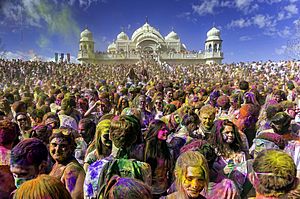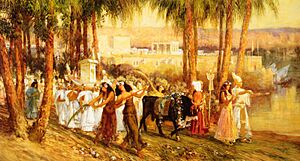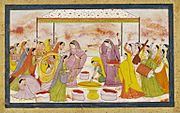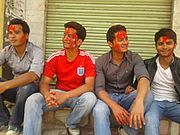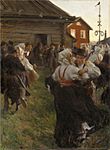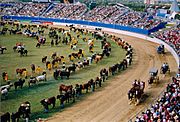Festival facts for kids
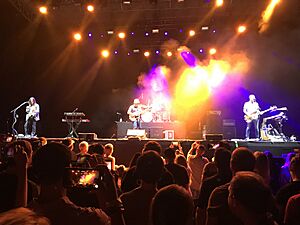

A festival is a special event celebrated by a group of people. It often focuses on important parts of their religion or culture. Festivals can be local or national holidays. Many festivals are linked to farming, especially harvest time, because food is so important. For example, events like Halloween in the northern part of the world and Easter in the southern part happen in autumn. They combine religious thanks with celebrating good harvests.
Festivals help communities in many ways. They can remember important events or thank gods, goddesses, or saints. These are called patronal festivals. Festivals also offer entertainment, which was very important before we had so much entertainment available. Festivals that focus on culture or ethnic groups teach people about their traditions. Older people often share stories and experiences, which helps families feel closer. People go to festivals to have fun, meet others, and feel like they belong to a community.
Contents
What Does "Festival" Mean?


The word "festival" first came from Latin and Old French in the late 1300s. Back then, a "festival dai" meant a religious holiday.
The word "festival" was first used as a noun (a thing) in 1589. The word "feast" was used as a noun around 1200.
The word gala comes from an Arabic word meaning "robe of honor." At first, "gala" described fancy clothes. But by the 1700s, it also meant a special celebration, like a festival.
History of Festivals

Festivals have always been a big part of human culture and history. They are found in almost every culture. Festivals are important in both private and public life, and for both non-religious and religious reasons. Ancient Greek and Roman societies had many festivals for their communities and governments. For example, Saturnalia likely influenced Christmas and Carnival.
Many festivals celebrate social events, religion, and nature. Some festivals have been around for hundreds of years. For instance, some traditional festivals in Ghana existed before Europeans arrived in the 1400s. Festivals became even more popular after World War II. The Avignon Festival and the Edinburgh Festival Fringe, both started in 1947, helped shape how modern festivals work. Art festivals became very common by the early 2000s. Today, festivals are often seen as a way to attract tourists, even though many are run by the government or are non-profit groups.
Festival Traditions
Many festivals started with religious beliefs and mix cultural and religious meanings into their activities. Important religious festivals like Christmas, Rosh Hashanah, Diwali, Holi, Eid-al-Fitr, and Eid-al-Adha help mark the year. Others, like harvest festivals, celebrate changes in the seasons.
Events from history, such as big military victories or other events that helped build a nation, also inspire festivals. An early example is the festival started by the ancient Egyptian Pharaoh Ramesses III to celebrate his win over the Libyans. In many countries, royal holidays remember events about kings and queens, just as farming holidays are about harvests. Festivals are often celebrated every year.
There are many types of festivals around the world. Most countries celebrate important events or traditions with special cultural activities. Most festivals end with eating specially prepared food, showing the link to "feasting." They also bring people together. Festivals are often connected to national holidays.
Types of Festivals
Festivals can be different sizes. They can be local, just for a town, or national, for a whole country. For example, music festivals often bring together people from many different places. However, most festivals are local, smaller, and popular with everyday people. It's hard to count all the festivals because there are so many different kinds.
Religious Festivals
In many religions, a feast is a set of celebrations to honor God or gods. A feast and a festival have historically meant the same thing. Most religions have festivals that happen every year. Some, like Passover, Easter, and Eid al-Adha, are "moveable feasts." This means their dates change based on lunar cycles, farming seasons, or the calendar used.
For example, the Sed festival celebrated the 30th year of an Egyptian pharaoh's rule, and then every three or four years after that. Among the Ashantis in Ghana, many traditional festivals are linked to sacred places. Celebrating these festivals every year helps protect these natural sites and their plants and animals. Vodoun Days in Benin is another religious festival that invites people from nearby countries like Togo and Ghana because they share similar cultures. In Togo, the Godogbe za of Gblinkomegan is a traditional celebration based on honoring ancestors.
In the Christian calendar, the two main feasts are Christmas (the birth of Jesus) and Easter (the resurrection). But smaller festivals honoring local patron saints are celebrated in almost all Christian countries. In the Catholic, Eastern Orthodox, and Anglican churches, there are many smaller feasts throughout the year. These remember saints, holy events, or beliefs. In the Philippines, every day of the year has at least one religious festival, whether Catholic, Islamic, or from local traditions.
Hindus celebrate many festivals, such as Navaratri, Holi, Rama Navami, Karva Chauth, Diwali, Pongal, and Kartika Purnima. Not all Hindus celebrate every festival. One example is Ganesh Chaturthi, which honors the god Ganesha and is celebrated across India, especially in Maharashtra. During this festival, statues of Ganesha, often made of clay, are worshipped. After a few days, they are placed in water. This public celebration, including parades, was encouraged by Bal Gangadhar Tilak to help Hindus feel united during the time of the British Raj.
Buddhist religious festivals, like Esala Perahera, are held in Sri Lanka and Thailand. The Sikh community celebrates the Vaisakhi festival, which marks the new year and the birth of the Khalsa.
- Religious festivals
Arts Festivals
Arts festivals celebrate creative achievements. These include science festivals, literary festivals (for books and writing), and music festivals. There are also specific types like comedy festivals, rock festivals, jazz festivals, and buskers festivals (for street performers). Other examples are poetry festivals, theatre festivals, and storytelling festivals. Re-enactment festivals, like Renaissance fairs, bring history to life. In the Philippines, February is known as national arts month, celebrating all art festivals across the country. Modern music festivals started in the 1960s and 70s and are now a big global business. Some older ones, like the Three Choirs Festival, have been around since the 11th century.
Film festivals show many different movies and usually happen every year. Some of the most famous film festivals are the Berlin International Film Festival, the Venice Film Festival, and the Cannes Film Festival.
- Arts festivals
-
Pushkin Poetry Festival, Russia
-
Television studio at the Hôtel Martinez during the Cannes Film Festival, France (2006)
-
The opening ceremony at the Woodstock rock festival, United States (1969)
A food festival is an event that celebrates food or drinks. These often show off what producers from a certain area make. Some food festivals focus on one specific food, like the National Peanut Festival in the United States or the Galway International Oyster Festival in Ireland. There are also drink festivals, like the famous Oktoberfest in Germany for beer. Many countries have festivals to celebrate wine. One example is the worldwide celebration of Beaujolais nouveau, a new wine shipped around the world for its release every November. Both Beaujolais nouveau and the Japanese rice wine sake are linked to harvest time. In the Philippines, there are at least 200 festivals for food and drinks.
- Food and drink festivals
-
Soweto Wine Festival, South Africa (2009)
-
Holi India (2011)
-
La Tomatina, Spain (2010)
-
Beer horse cart from the Hofbräuhaus brewery at Oktoberfest Germany (2013)
Seasonal and Harvest Festivals
Seasonal festivals, like Beltane, are set by the sun and moon cycles, and by the changing seasons. This is especially true because seasons affect food supply. There are many ancient and modern harvest festivals. Ancient Egyptians depended on the yearly flooding of the Nile River, which made the land fertile for crops. In the Alps, in autumn, farmers celebrate the return of their cattle from mountain pastures to the valley stables. This is called Almabtrieb.
The Chinese New Year is a well-known winter festival. It is set by the lunar calendar and celebrated from the second new moon after the winter solstice. The Dree Festival of the Apatanis people in India is celebrated every year from July 4 to 7. They pray for a good crop harvest.
Midsummer or St. John's Day is a seasonal festival. It is linked to a Christian saint's feast day and also celebrates the summer solstice in the northern part of the world. It's very important in Sweden. Winter carnivals also allow people to celebrate creative or sports activities that need snow and ice. In the Philippines, every day of the year has at least one festival celebrating the harvest of crops, fish, or other local goods.
- Seasonal and harvest festivals
-
Château de Montsoreau-Museum of Contemporary Art Sky lantern Festival, in Loire Valley
-
Midsummer dance by Anders Zorn, Sweden (1897)
-
Tanabata summer festival in Sendai, Japan
-
Halloween pumpkins show the close link between harvest and religious festivals
-
Kalise Festival in Spain
Festivals and Communities
Experts say that festivals help spread important community values and ideas. They can change how people feel about a place. A festival can also help people achieve "certain ideals," like a sense of identity or shared beliefs. Festivals can be used to improve a city's image. Because festivals are temporary, their impact is often about a city's name, memories, and how people see it. By being different from everyday life, festivals can make social, cultural, or economic traditions stronger.
Studying Festivals
- Festive ecology – This field looks at how the symbols and natural surroundings (plants, fungi, animals) are connected to cultural events like festivals and special occasions.
- Heortology – This is the study of religious festivals. It first focused on Christian festivals but now includes all religions, especially those from Ancient Greece.
See also
 In Spanish: Festival para niños
In Spanish: Festival para niños
- All pages with titles containing "Festival"
- Convention
- Event planning
- Fair
- Festive ecology
- Holiday
- Lists of festivals
- Outline of festivals
- Patronal festival
- Procession
- Trade show


